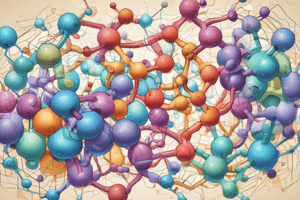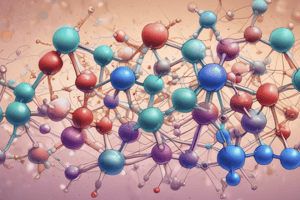Podcast
Questions and Answers
What typically happens to the Vmax when a competitive inhibitor is introduced to an enzyme-substrate system?
What typically happens to the Vmax when a competitive inhibitor is introduced to an enzyme-substrate system?
- It increases
- It decreases
- It fluctuates unpredictably
- It remains unchanged (correct)
What does the y-intercept of a Lineweaver-Burk plot represent?
What does the y-intercept of a Lineweaver-Burk plot represent?
- Enzyme concentration
- 1/Vmax (correct)
- Substrate concentration
- Km
Why are transition-state inhibitors often not feasible to develop?
Why are transition-state inhibitors often not feasible to develop?
- They are too reactive
- They do not bind effectively
- They have no biological activity
- They require complex synthesis (correct)
What is a common issue with suicide inhibitors in enzymatic reactions?
What is a common issue with suicide inhibitors in enzymatic reactions?
Which statement about transition-state inhibitors is correct?
Which statement about transition-state inhibitors is correct?
What could a [REDACTED] rate indicate about blood pH?
What could a [REDACTED] rate indicate about blood pH?
What drives the [REDACTED] effect in protein interactions?
What drives the [REDACTED] effect in protein interactions?
What most likely causes a peptide bond to behave differently than other bonds?
What most likely causes a peptide bond to behave differently than other bonds?
What happens to hemoglobin's affinity for oxygen when it moves through blood?
What happens to hemoglobin's affinity for oxygen when it moves through blood?
In first-order kinetics under Michaelis-Menten, what does the asymptotic behavior of velocity indicate?
In first-order kinetics under Michaelis-Menten, what does the asymptotic behavior of velocity indicate?
What effect does a mutation causing an alpha-helix to unwind typically have on protein structure?
What effect does a mutation causing an alpha-helix to unwind typically have on protein structure?
What describes the structure of a protein domain?
What describes the structure of a protein domain?
Which option describes an interaction most likely to generate a bond with the greatest polarity?
Which option describes an interaction most likely to generate a bond with the greatest polarity?
Which factor primarily determines the concentration of proton in a solution?
Which factor primarily determines the concentration of proton in a solution?
Which assumption is necessary to apply Michaelis-Menten kinetics?
Which assumption is necessary to apply Michaelis-Menten kinetics?
What is the resulting Vmax if [S] equals Km?
What is the resulting Vmax if [S] equals Km?
In what environment would hydrogen bonds be least stable?
In what environment would hydrogen bonds be least stable?
What is the relationship between pKa and pH for an acid in solution?
What is the relationship between pKa and pH for an acid in solution?
How would you identify an amino acid with titration curves similar to another?
How would you identify an amino acid with titration curves similar to another?
Which of the following describes the proper naming of an amino acid based on its structure?
Which of the following describes the proper naming of an amino acid based on its structure?
What happens to amino acids involved in hydrogen bonding in an alpha helix?
What happens to amino acids involved in hydrogen bonding in an alpha helix?
Flashcards are hidden until you start studying
Study Notes
Exam Overview
- Short answer questions may not follow sequential order due to randomization.
- Certain terms and data are redacted, indicating missing information.
Protein Structure and Amino Acids
- Understanding the identification of amino acids and their single letter abbreviations is essential.
- Investigate the impact of mutations on protein structures, particularly alpha-helix formations.
- Analyze amino acid side-chains for similarities in titration curves.
- Identify hydrogen bonding partners in alpha helix sequences.
Acid-Base Chemistry
- Determine pH levels based on given concentrations and data.
- Recognize the strongest acidic solutions based on pH levels.
- Relate proton concentrations to pH and pOH.
- Understand the influence of pKa on acid dissociation in solutions.
Enzymatic Kinetics
- Familiarize with Michaelis-Menten kinetics for enzyme catalysis.
- Key assumptions for kinetics analysis include the behavior of reaction rates and velocity.
- Vmax and Km values are critical parameters for enzyme activity, expressing maximum velocity and affinity.
- The effect of inhibitors on enzymatic reactions, including changes reflected in Lineweaver-Burk plots, should be understood.
Protein Domains and Structural Biology
- Define domains within protein structures and their significance in folding and function.
- Explore driving forces behind critical biological phenomena such as aggregation in aqueous solutions.
Inhibitors and Therapeutics
- Understand the challenges faced by specific inhibitors within enzyme systems, including transition-state and suicide inhibitors.
- Discuss the implications of using Lineweaver-Burk plots for analyzing enzyme kinetics, particularly in the presence of inhibitors.
General Tips
- Pay attention to the specific causes of structural failure in proteins due to mutations.
- Deconstruct complex statements to verify correctness and pinpoint errors in reasoning.
- Familiarize with practical applications of theoretical concepts in real biological systems.
Studying That Suits You
Use AI to generate personalized quizzes and flashcards to suit your learning preferences.




